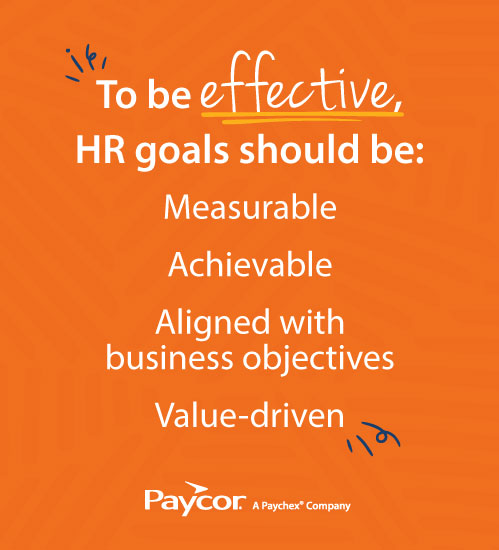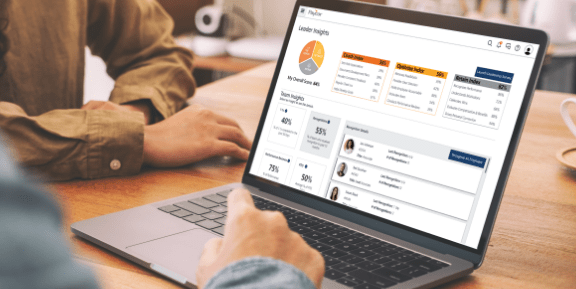It’s OK not to be the smartest person in the room. However, you don’t want to be the person in the room without HR SMART goals.
SMART – specific, measurable, achievable, relevant, and time-bound – goals, when applied to HR initiatives, help crystalize previously vague objectives to enhance the employee experience. Whether the objective is to improve recruitment efficiency, boost employee engagement, or develop leadership capabilities, HR SMART goals establish a powerful framework to keep your efforts focused, impactful, and eventually successful.
Read on to learn more on how SMART goals help bolster HR functions to better support business objectives.
What Are HR Goals?
HR smart goals are strategic objectives that Human Resources teams set that align with the mission and vision of the business. By defining what their department wants to achieve, whether that is with talent acquisition, employee engagement and retention, performance management, workplace culture, and even compliance, HR can prioritize initiatives to achieve results.
The impact on the company is simple: improvement in each of these areas leads to happier, more engaged employees and ultimately an increase in productivity. One study found highly engaged employees are 14% more productive and companies with those employees show 23% higher profitability (Gallup).
Importance of Setting HR Goals
HR professionals who set HR goals and objectives gain countless benefits, as does the department and business they work for, including:
Enhanced Focus
Individuals can develop a road map for their HR initiatives or projects to remove ambiguity. With a clear understanding of what needs to be achieved and the deadline for when it must be achieved, it’s easier to maintain focus.
Improved Accountability
This is about metrics and evaluating performance. Holding individuals accountable based on measurable results helps foster a culture of ownership.
Strategic Alignment with Business Objectives
HR efforts shouldn’t be isolated or mere one-offs. Instead, HR should make goals that are relevant and directly linked to broader organizational objectives. This could mean enhancing customer satisfaction or improving financial performance.
Increased Motivation and Engagement
It’s great to set ambitious goals—ones that really push you—but even those should still be realistic enough that you can actually reach them. Why? Individuals who can identify with the relevance of a goal and achieve it gain a major boost in motivation, plus the positive reinforcement of accomplishment encourages continued effort.
Better Decision-Making and Resource Allocation
An individual needs resources to achieve the desired objective. Using the structure of SMART goals, HR leaders are compelled to make data-driven decisions critically about what they need at their disposal to feasibly accomplish the task or project at hand. Such thinking leads to better decisions on what budget to provide, what technology might be needed, and much more.
How Do HR Goals Support Business Goals?
HR goals play a big part in making a business better. When these goals are clear and specific, employees know what’s expected and can focus their energy on the right tasks. To be effective, HR goals should be:
- Measurable: Use metrics to track progress and know when adjustments are needed.
- Achievable: Set goals that are realistic so the team stays motivated and accountable.
- Aligned with business objectives: Make sure goals support the company’s overall direction.
- Value-driven: Aim for goals that actually add value, like improving productivity through employee engagement.
For example, rising productivity often points to strong HR initiatives—37% of HR professionals say effective HR work leads directly to better productivity (HR.com, 2025).

How to Determine HR Goals and Objectives
When an HR professional sets clear goals and objectives, it gives the team structure. The focus shifts from just managing tasks to making a real strategic impact. It’s not just about getting things done—it’s about helping the business reach its bigger goals.
HR professionals who establish long-term HR goals have an eye on shaping the workforce of the future. The opportunity presents itself to be proactive about:
- Developing sustainable talent pipelines
- Building leadership skills
- Fostering a positive culture
- Strategically planning for skills requirements
Working toward any or all these objectives places the HR department at the table of high-level decision making, emphasizing its value as a strategic partner who contributes to sustainable growth.
Examples of SMART Goals for HR Departments and Teams
HR teams have a number of areas to apply SMART goals, including:
HR Goals for Talent Acquisition
An HR director should define the strategic direction for attracting, sourcing, and hiring good talent. This means finding and building a diverse, skilled workforce that can ultimately help the company meet its long-term objectives.
A few examples are:
- Improve quality of hire,which could be wanting to achieve an average quality of hire score of 4.0/5.0 within a specific quarter.
- Reduce time-to-hire in new fiscal year for key roles by a 15%
- Enhance employer brand by a 20% in the next 12 months.
HR Goals for Onboarding
HR should make it a goal when onboarding new hires to set them up for long-term success, immersing them in the company culture, fostering early engagement, and clarifying expectations from the word “Go.”
Some examples of onboarding HR SMART goals include:
- Increase new hire retention to at least 90% within their first year by the end of the next fiscal year, as measured by HR retention reports.
- Reduce the average time it takes for new hires to reach full productivity from 120 days to 90 days within the next 12 months, as tracked by performance metrics and manager assessments.
- Ensure 100% of managers complete all required onboarding tasks and conduct at least three documented check-ins with each new hire during their first 90 days of employment, to be reviewed quarterly.
HR Goals for Talent Management
Talent management goals focus on developing, retaining, and optimizing the performance of existing employees. This allows the HR team to build a sustainable workforce, which helps ensure the organization has the right skills and leadership for future challenges.
A few examples include:
- Identify at least 15% of employees as high-potential for future leadership roles by the end of Q2, and enroll 100% of them in mentorship and leadership training programs within the next 12 months.
- Increase the percentage of open positions filled internally from 25% to 40% within the next fiscal year by improving job posting visibility through monthly internal communications and targeted outreach.
- Conduct quarterly assessments to identify critical skill gaps and require all employees to complete at least one relevant professional development course annually, with completion rates tracked and reported at year-end.
HR Goals for Employee Engagement
Human resource goals for employee engagement should center around fostering a workplace that values employees and encourages them to be committed to their work and the business’s success.
Here are some employee engagement SMART goal examples:
- Raise employee engagement scores from 65% to 75% by the end of 2025, as measured by annual engagement surveys.
- Launch a peer-to-peer recognition program by Q3, with a target of at least 60% employee participation within the first year.
- Decrease reported employee burnout rates by 20% and increase satisfaction with work-life balance by implementing flexible work options and wellness programs, with progress tracked through biannual employee surveys over the next 12 months.
SMART Goals for HR Professionals and Employees
Now that we’ve explored SMART goals for an HR department, let’s zoom in to see how applying the same specific, measurable, achievable, relevant, and time-bound goals to HR professionals helps elevate employee contributions and careers.
HR Generalist Goals
An HR Generalist largely is involved in day-to-day HR operations and contributes to strategic initiatives. They focus on supporting employees, ensuring compliance, and improving a range of HR processes in areas of recruitment, onboarding, employee relations, to name a few.
One example of an HR generalist goal is:
- Increase employee understanding of key HR policies by administering quarterly short surveys and achieve at least an 85% correct response rate by year-end; ensure 100% of new employees complete all compliance training within 30 days of hire, tracked and reported monthly.
HR Coordinator Goals
HR Coordinators generally handle communication and support the HR team and employees through record keeping Setting SMART HR goals helps enhance efficiency, accuracy, and contributes to the overall functioning of the HR department.
Examples of SMART goals for an HR coordinator:
- Improve HR Information System (HRIS) data accuracy by conducting weekly audits and correcting 10% of discrepancies.
- Streamline onboarding documentation within the first quarter by optimizing form collection and digital workflows to reduce the time it takes to complete new hire paperwork by half.
HR Manager Goals
The HR Manager bridges strategy with operation. These individuals often implement programs and optimize processes to foster a productive and engaged workforce. They’re responsible for team performance, employee relations, and ensuring HR contributes directly to business objectives.
Examples of HR manager goals:
- Launch an integrated performance management system by Q4, requiring at least 90% of managers to complete system training and 100% of employees to begin using the system within 60 days of rollout, with adoption rates tracked monthly.
- Improve managerial HR competencies by ensuring 100% of line managers complete mandatory training on effective feedback delivery by the end of Q2 and target a 15% increase in employee perception of managerial support on the annual employee survey.
HR Goals for Directors
HR directors aim to create strategy – big-picture initiatives – and alignment with business goals. They focus on driving organizational change, building a culture around high performance, and finding ways to leverage the workforce to gain a competitive advantage.
Examples of HR director goals include:
- Establish and fully implement a company-wide succession planning framework by the end of Q3, identifying and developing at least 20% of employees as potential successors for critical roles, with progress reviewed biannually.
- Lead the integration of a new HRIS system and reduce manual administrative HR tasks by 30% within six months of implementation, as measured by workflow analysis and employee feedback.
Best Practices: How to Set HR Goals
Setting HR SMART goals helps drive performance to achieve strategic objectives. Here are a few best practices that can help you stand out:
- Avoid being vague when setting HR goals, choosing clarity that helps the team focus. For instance, “boost employee morale” is too broad, whereas “increase participation by 15% in the next quarter for our professional development program” pinpoints exactly what you’re trying to accomplish.
- Use concrete numbers, as in the example above, because it makes tracking progress easier.
- The targets of your goals need to be realistic and consider the time and resources you have at your disposal.
- Your goals must directly support the big picture for HR and the business.
- Meet your deadlines. Although a firm deadline creates urgency, accomplishing a challenging HR goal in a set timeframe demonstrates true success. Since some goals involve projects that occur over time – a quarter or annually – make sure to regularly monitor progress, provide support when necessary, and be transparent when communicating updates.
How Paycor Helps You Set SMART Goals
Paycor offers HCM software that can help you achieve your HR goals. Our Talent Development platform enables goal tracking (including cascading organizational, departmental, and personal goals), performance reviews, and continuous feedback. And our AI Analytics Assistant features provide insights into workforce data, aiding in informed decision-making and progress measurement for HR initiatives.
Achieve Your Goals with Paycor
If you still have questions or want additional information about how Paycor helps transform your approach to HR, and ultimately your workforce and the overall business, then take a guided product tour.









